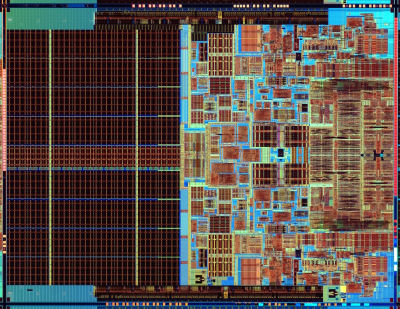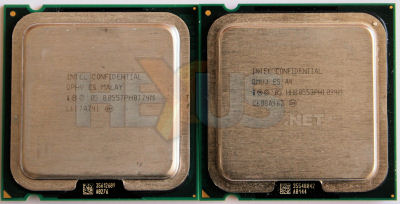Overview and architecture analysis
Overview
Intel's new Core 2 architecture builds on the foundations laid down by the Core micro-architecture which debuted on Intel's current range of dual-core mobile CPUs. Again, those unfamiliar to the new terminology may know them as Yonah.Let's be clear about this. Intel, by moving away from NetBurst and the ultra-high clockspeeds required for the Pentium 4 series to be competitive against AMD's Athlon 64 series, has decided that a new micro-architecture was required that would provide both excellent performance and be energy-efficient, too. That, then, spelt an end to the Pentium 4 as Intel's consumer CPU of choice. It's still around, of course, but Core 2 Duo/Extreme is now positioned as Intel's performance CPU.
The following table details the range of Core 2-based CPUs Intel will be offering right off the bat, along with a Pentium Extreme Edition 965 and Athlon 64 FX-62 for reference. We'll then discuss the reasons behind why Core 2 is destined to give AMD a very hard time.
| Processor name | Intel Core 2 Duo E6300 | Intel Core 2 Duo E6400 | Intel Core 2 Duo E6600 | Intel Core 2 Duo E6700 | Intel Core 2 Extreme X6800 | Intel Pentium E.E 965 | AMD Athlon 64 FX-62 (AM2) |
|---|---|---|---|---|---|---|---|
| Form factor | LGA775 | LGA775 | LGA775 | LGA775 | LGA775 | LGA775 | AM2 |
| Manufacturing process | 65nm | 65nm | 65nm | 65nm | 65nm | 65nm | 90nm |
| Physical cores | 2 | 2 | 2 | 2 | 2 | 2 | 2 |
| Inst. per clock* | 4 | 4 | 4 | 4 | 4 | 3 | 3 |
| Pipeline stages | 14 | 14 | 14 | 14 | 14 | 31 | 12 |
| Clock speed | 1.83GHz | 2.13GHz | 2.40GHz | 2.67GHz | 2.93GHz | 3.73GHz | 2.8GHz |
| FSB | 266MHz (1066MHz QDR) | 266MHz (1066MHz QDR) | 266MHz (1066MHz QDR) | 266MHz (1066MHz QDR) | 266MHz (1066MHz QDR) | 266MHz (1066MHz QDR) | 200MHz |
| Memory support** | DDR2, 800MHz, DC | DDR2, 800MHz, DC | DDR2, 800MHz, DC) | DDR2, 800MHz, DC) | DDR2, 800MHz, DC | DDR2, 800MHz, DC | DDR2, 800MHz, DC |
| L1 cache total (per core) | 64KiB | 64KiB | 64KiB | 64KiB | 64KiB | 28KiB | 128KiB |
| L2 cache total | 2MiB | 2MiB | 4MiB | 4MiB | 4MiB | 4MiB | 2MiB |
| ISA | x86, x86-64, SSE-SSE3 | x86, x86-64, SSE-SSE3 | x86, x86-64, SSE-SSE3 | x86, x86-64, SSE-SSE3 | x86, x86-64, SSE-SSE3 | x86, x86-64, SSE-SSE3 | x86, x86-64, SSE-SSE3 |
| TDP | 65W | 65W | 65W | 65W | 75W | 130W | 125W |
| Operating voltage | 1.2-1.3625V | 1.2-1.3625V | 1.2-1.3625V | 1.2-1.3625V | 1.2-1.3625V | 1.3-1.4V | 1.3-1.4V |
| Price | $183 | $224 | $316 | $530 | $999 | $899 | $999 |
A couple of things to note about the table. It doesn't necessary tell you why Core 2 Duo/Extreme is fast but it does highlight the fact that current models are only differentiated by clockspeed and L2 cache levels. Of course, faster speed grades inevitably bring along higher prices.
Models
Intel is initially launching Core 2 Duo at a starting speed-grade of 1.83GHz. This model, designated E6300, will be equipped with 2MiB of L2 cache and falls under the codename of Allendale. We expect Intel to release a lower-clocked version in the near future. Other than a lower clock speed and 2MiB L2 cache, the E6300 is, for all intents and purposes, architecturally identical to the rest of the Duo range; it's no Celeron model. That's especially gratifying with respect to its relatively low price.
The range is headlined by the Intel Core 2 Extreme X6800, which operates at 2.93GHz and, like Extreme Editions before, is multiplier-unlocked. Deep-walleted enthusiasts will have some fun with this one.
Let's digest the information above, particularly the architectural elements, with some insightful commentary.
Architecture analysis
Here's what makes the Core 2 Duo tick, folks.Dual-core support
Intel Core 2 Duo-based CPUs will harness two execution cores based on a single piece of silicon. The cores communicate with the rest of the system via a single bus, which will be clocked in at 1066MHz and offer around 8.5GB/s CPU-to-MCH bandwidth. Initial Core 2 Duo CPUs will be manufactured on Intel's proven 65nm process. Projections state that 45nm production will begin in Q2 2007. Core 2 Duo supports a 14-stage execution pipeline, down (read better) from the 31 present on the Prescott-based Pentium 4.

See, two cores. What would happen if Intel put another two on? Kentsfield, anyone?
CPUs will be packaged in the present LGA775 form factor, and most i975X chipset-based (CrossFire-compatible) motherboards that are manufactured post-April 2006 will support its differing power requirements. Intel is also launching a range of new chipsets, the P965-series, that will carry native Conroe support. We've got a couple of models in our labs. and we'll be bringing you benchmark results shortly. We'll also be seeing competing chipsets from the likes of ATI and NVIDIA in due course, with the latter offering Core 2 Duo support alongside SLI.
Wide Dynamic Execution
Current x86 processors can deliver 3 instructions per clock cycle. Core 2 Duo, however, has been architected to fetch, dispatch, execute and retire up to four full instructions simultaneously, offering a 33% boost over, say, a Pentium 4 CPU. Allied to this, Core 2 Duo also supports what Intel terms Macro-Fusion, which can combine certain common x86 instructions (pairs, say, compare and conditional jump) into a single instruction (micro-op) for execution, thereby reducing overall processing time. Processing efficiency is the name of the game here.
Intel Smart Memory Access and Advanced Smart Cache
Higher-end Core 2 Duo CPUs will be equipped with 4MiB of on-chip L2 cache, minimising the need to run back to system memory for frequently used data. Unlike the present Pentium 4 micro-architecture, Core 2 Duo's two cores will share the cache amongst each other. Intel's engineering team has found that forcing the cores to individually allocate and use cache is more efficient than allotting a fixed, per-core amount. By varying the amount of cache split over the two cores Intel hopes that cache misses, the bane of modern CPUs in terms of execution efficiency, will be further reduced.
Core 2 Duo also supports what Intel terms Smart Memory Access. Put simply, and falling under the banner of memory disambiguation, it's a form of out-of-order, built-in intelligence that predicts and loads the upcoming instruction data before current store instructions have been processed. Intel has designed algorithms that can accurately predict whether a load can be processed before the store, thereby, again, potentially saving overall execution time.
Coupled with a heavily optimised cache, and thinking about it how it all fits together, the Core 2 Duo's memory access latency will be better than the present Pentium 4's, for the reasons discussed above. Intel has toyed with the idea of integrating a memory controller right on the CPU die itself, a la AMD, but reckons that Core 2 Duo's intelligent architecture masks latency well enough for it to do without. We'll put this assertion to the test in our ScienceMark 2.0 memory latency analysis.
Advanced Media Boost
Increasing efficiency with Streaming SIMD (Single Instruction Multiple Data) Extentions, Core 2 Duo CPUs are able to process a 128-bit instruction in a single clock cycle, rather than requiring the incumbent two clocks that current generations employ.
Intelligent Power Capability
Intel has designed Core 2 Duo not only to perform well on a clock-for-clock basis but also to be energy-efficient whilst doing so. This is precisely where its mobile heritage shines through. Intelligent, which seems to be the watchword for Core 2 Duo, management monitors core usage and application requirements such that it can power-gate parts of the CPU when not in use; there's little need for two cores running at full power in single-threaded applications, for example. Intel reckons that it has improved the physical requirements of power-gating enough for it to offer better power consumption than previous generations'.
Intel indicates that all Core 2 Duo models (barring Extreme) will harness a 65W TDP; half that of the Pentium Extreme Edition 965 CPU. The Core 2 Duo Extreme, however, ships with a slightly higher 75W TDP.
Further, Conroe will ship with an integrated digital thermal sensor. The sensor is embedded on the die itself and will give more-accurate readings. Incidentally, the 965 Express chipset family supports Intel Quiet System Technology, which intelligently manages processor and system fan-speeds in relation to core temperature, ensuring the fan(s) are spun just fast enough to keep the processor from throttling.
Virtualisation Technology, 64-bit processing
Virtualisation Technology offers hardware-isolated virtual partitions that allow the user to run multiple operating systems on one PC, and 64-bit processing (EMT64), along with Execute Disable Bit, is carried over from the Pentium 4 line of CPUs.
Overall thoughts
Intel's Core 2 Duo micro-architecture is the desktop arm of a multi-pronged assault. The mobile version, Merom, takes much of what makes Core 2 Duo good and adds in number of extra power-management features. Woodcrest, the codename for the current server- and workstation-based Intel Xeon DP5100-series, again takes the micro-architecture as a base, thereby completing a top-to-bottom family line-up. Intel's invested heavily in its Core (2) micro-architecture and it's now pervasive across platforms.How does it look?

One's an engineering sample Core 2 Extreme X6800 and the other an E.E 965. Which is which?

A look at the back offers some clues. Core 2 Extreme is on the left on both pictures. They're both LGA 775 processors and the Core 2 Extreme magic is contained under the heatspreader.









